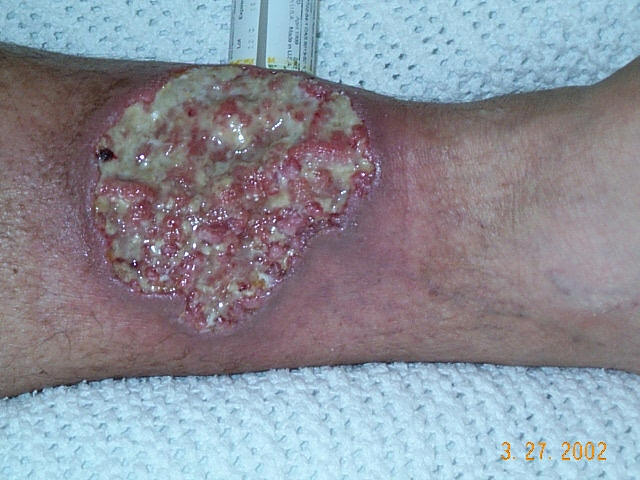What are the symptoms of pyoderma gangrenosum?
Pyoderma gangrenosum is a rare, inflammatory skin condition characterized by painful ulcers. The symptoms often include:
- Skin Ulcers: The primary symptom is the development of painful, deep ulcers or sores on the skin. These ulcers typically start as small, red bumps or blisters that rapidly progress to larger, necrotic (dead tissue) ulcers with a purple or blue border.
- Rapid Growth: The ulcers can expand quickly and may be irregular in shape. They often have a purulent (pus-filled) center and can be quite painful.
- Pain and Tenderness: The affected areas are usually painful and tender to the touch.
- Swelling: The surrounding skin may become swollen and inflamed.
- Fever and Malaise: In some cases, individuals may experience systemic symptoms like fever, fatigue, or a general feeling of being unwell.
- Scarring: As the ulcers heal, they can leave behind scars or areas of hyperpigmentation (darkening of the skin).
Pyoderma gangrenosum can occur anywhere on the body but is most commonly seen on the legs. The condition often occurs in conjunction with underlying health issues such as inflammatory bowel disease (Crohn’s disease or ulcerative colitis), rheumatoid arthritis, or other systemic conditions. If you suspect pyoderma gangrenosum or experience similar symptoms, it’s important to seek medical evaluation for appropriate diagnosis and management.
What are the causes of pyoderma gangrenosum?
Pyoderma gangrenosum is a complex and rare skin condition with unclear exact causes, but several factors and underlying conditions are known to be associated with it:
- Underlying Health Conditions: Pyoderma gangrenosum often occurs in individuals with other medical conditions, including:
- Inflammatory Bowel Disease (IBD): Such as Crohn’s disease or ulcerative colitis.
- Rheumatoid Arthritis: An autoimmune disorder that affects the joints.
- Systemic Lupus Erythematosus (SLE): A systemic autoimmune disease.
- Behçet’s Disease: A rare inflammatory condition causing ulcers in the mouth and genital area.
- Hematologic Disorders: Including leukemia and multiple myeloma.
- Autoimmune Reaction: Pyoderma gangrenosum is considered to be an autoimmune disorder where the body’s immune system mistakenly attacks healthy skin tissue.
- Trauma or Surgery: In some cases, the condition can be triggered or worsened by trauma or surgical procedures. This is known as the “pathergy” phenomenon, where minor injuries or trauma lead to the development of new lesions.
- Infections: While not a direct cause, infections or skin injuries can sometimes exacerbate the condition or trigger an outbreak.
- Genetic Factors: Although not well understood, there may be a genetic predisposition or familial tendency to develop pyoderma gangrenosum.
- Medications: In rare cases, certain medications may be associated with triggering or worsening the condition.
Overall, the precise mechanism behind pyoderma gangrenosum is not fully understood, and it is often associated with underlying systemic or autoimmune conditions. Managing pyoderma gangrenosum typically involves addressing both the skin lesions and any underlying conditions that may be contributing to the development of the ulcers.
What is the treatment for pyoderma gangrenosum?
Treatment for pyoderma gangrenosum focuses on controlling symptoms, promoting healing of the ulcers, and addressing any underlying conditions. The approach usually includes:
- Medications:
- Corticosteroids: Oral or topical corticosteroids are commonly used to reduce inflammation and promote healing of the ulcers.
- Immunosuppressive Drugs: Medications such as cyclosporine, azathioprine, or mycophenolate mofetil may be prescribed to suppress the immune system and control inflammation.
- Biologics: For severe cases or those associated with inflammatory bowel disease or other autoimmune conditions, biologic agents like infliximab or adalimumab may be used.
- Antibiotics: If there is a secondary bacterial infection, antibiotics may be prescribed.
- Wound Care:
- Proper Dressing: Regularly changing wound dressings and using appropriate wound care techniques to manage ulcers and prevent infection.
- Debridement: In some cases, removing necrotic (dead) tissue from the ulcers may be necessary to promote healing.
- Treating Underlying Conditions: Addressing and managing any underlying health conditions, such as inflammatory bowel disease or rheumatoid arthritis, can help improve the symptoms of pyoderma gangrenosum.
- Pain Management: Medications for pain relief may be used to manage discomfort associated with the ulcers.
- Lifestyle and Supportive Measures:
- Nutritional Support: Ensuring proper nutrition to support overall health and wound healing.
- Avoiding Trauma: Taking steps to avoid trauma or injury to affected areas, which could exacerbate the condition.
- Surgical Options: In severe cases or when conservative treatments fail, surgical intervention may be considered to remove affected tissue or debride ulcers, though this is generally approached with caution due to the risk of worsening the condition.
Treatment plans should be individualized based on the severity of the condition, the presence of underlying diseases, and the response to initial treatments. Regular follow-up with a healthcare provider is essential for monitoring progress and adjusting the treatment as needed.

Leave a Reply
You must be logged in to post a comment.